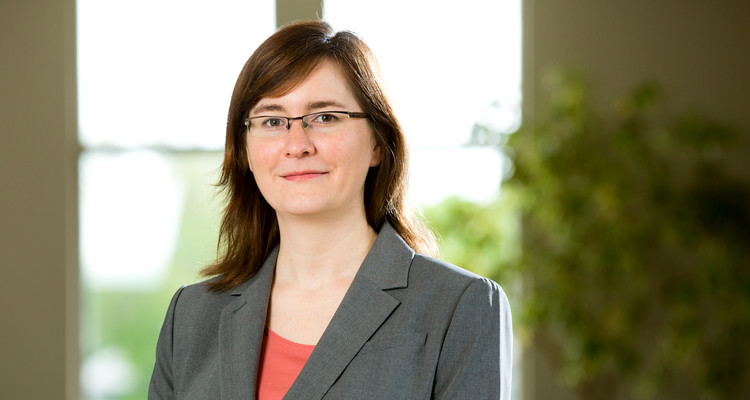Though I cannot imagine a better career than being a college professor, it only seems like the clear choice in retrospect – as a math and English double major at Williams College, I truly did not know what direction I would take. I was interested in learning as much as I could about anything and everything. I took classes in developmental psychology and read poetry from the Sufi mystic tradition.
When I decided to pursue engineering, I took night classes to catch up on the engineering undergraduate curriculum. Three years later, I was accepted to Johns Hopkins University, where I went on to earn a Ph.D. in civil engineering.
During my first year in grad school, while taking a course on finite element analysis, I came to realize the essential differences between engineering and math.
Finite element analysis is a tool used in modern engineering that has gained ground as computers have become more powerful
over the last several decades. It is essentially an approximation method. The more exactly you can describe a real physical system (from a car under impact, to a bridge under load, to fluid flow in a pipe) and the more time and computer processing power you expend (together these are sometimes called “computational cost”), the closer you can get to the true solution. It is a convergence method, meaning that with more computational effort, you converge on an exact solution.
But there is almost always some reasonably acceptable amount of error involved. Pure math requires a certain kind of exactness. Engineering is often about finding the best answer under the circumstances.
My core research addresses the “multiscale problem” in engineering mechanics. Consider a fiber-reinforced composite that has many fibers aligned on one axis of the material. The diameter of the fiber may be on a much smaller scale than the scale of the structure made out of this material (for example an aircraft).
There is often randomness in the material structure at the small scale. We wish to extract information about the safety and reliability of the large scale aircraft made up of composites. Where a huge amount of small scale information is available, there is also a huge computational cost in the time and computer processing power needed to solve the problem to the utmost level of detail. This may be infeasible or simply unnecessary.
Some of the big research questions I address are: How do we know what level of detail is necessary? How do we account for microstructural randomness? What are the ways in which local detail can be safely “left out” (or packaged in a different way) in order to solve the large scale problem?
Since I earned my Ph.D. in 2009, I have continued along this line of research, most recently giving an invited talk at a symposium of the International Union of Theoretical and Applied Mechanics (IUTAM). One of the first slides I showed to this audience from largely Ph.D. granting institutions acknowledged my team of undergraduate researchers at the University of St. Thomas.
I also have sought out interesting opportunities for my undergraduate research group to collaborate with researchers in applications. For example, we have collaborated with structural geologists to study buckling behavior in geological materials at a very large scale.
In a separate project, also initiated by a team of geologists, I have looked at the material behavior of a partially molten basaltic magma. In each case, I have brought engineering tools such as the finite element method to bear on problems outside the discipline. These projects have proven to be a wonderful way to involve undergraduate students in research that is inherently collaborative and multidisciplinary.
In a totally different research direction, I have looked at the behavior of polymer tape in wound rolls. Though tape may seem to have gone the way of the VCR, it is still used in modern data storage to contain extremely large volumes of data in a very cost effective way. A problem arises because polymer materials “relax” or lengthen over time when they are put under tension, which occurs inside a wound roll of tape. I have collaborated with INSIC (Information Storage Industry Consortium) to develop computer models of the distortion due to relaxation in the material that may occur in wound rolls over long periods of time.
At this early point in my career at St. Thomas, I look forward to fostering more diverse types of projects that build unique connections with industry and other academic disciplines. Through working on these collaborations, students are able to get a sense of the seemingly endless variety of applications of computer modeling of material behavior.
In the introduction to his classic 1968 text on plasticity in materials, Alexander Mendelson speaks of the need to reconcile “the physical and the mathematical,” to “both explain the material behavior and provide the engineer and scientist with the necessary tools for practical application.” To reconcile the physical and mathematical is to in some way make sense of our world.
Like many computational researchers, I often set my computer to run at nighttime so that the results may be ready in the morning. There are other computers like mine, all over the world, chugging through all kinds of approximation models, getting closer and closer to reconciling the physical and the mathematical. We always are getting closer and closer, but we can hardly ever, perhaps by virtue of being human, capture the true level of complexity in the physical systems we seek to understand.
I am fine with that – I hope to teach my students something of the beauty in trying.
Assistant professor Dr. Katherine Acton teaches in UST’s School of Engineering.
From Exemplars, a publication of the Grants and Research Office.







